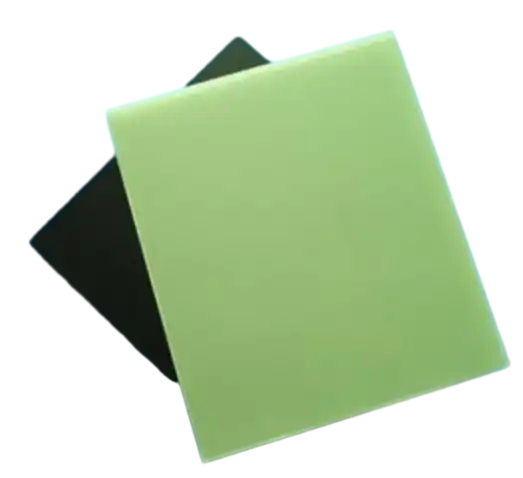Composition and Manufacturing Process
FR4 Sheet Composition
FR4 sheet is a composite material composed of woven fiberglass cloth impregnated with an epoxy resin binder. The "FR" in FR4 stands for "Flame Retardant," and the "4" indicates the material's relative flammability on a scale of 0 to 5. The fiberglass reinforcement provides strength and dimensional stability, while the epoxy resin offers excellent electrical insulation properties. FR4 sheets typically contain additives that enhance their flame-retardant capabilities, such as bromine compounds or phosphorus-based chemicals.
G10 Sheet Composition
G10 sheet, like FR4, is also a fiberglass-reinforced epoxy laminate. However, G10 does not contain the flame-retardant additives found in FR4. The absence of these additives results in a material with different mechanical and thermal properties. G10 sheets are known for their high strength-to-weight ratio, low moisture absorption, and excellent electrical insulation characteristics. The fiberglass reinforcement in G10 is typically a higher grade than that used in FR4, contributing to its superior mechanical properties.
Manufacturing Processes
Both FR4 and G10 sheets are manufactured using similar processes, but with some key differences. The production begins with the impregnation of fiberglass cloth with epoxy resin. For FR4, flame-retardant additives are incorporated into the resin mixture. The impregnated cloth is then partially cured to create a prepreg material. Multiple layers of prepreg are stacked and subjected to heat and pressure in a lamination process. This process fully cures the resin, creating a solid, uniform sheet. The specific manufacturing parameters, such as curing temperature and pressure, can be adjusted to fine-tune the properties of the final product.
Physical and Mechanical Properties
Strength and Durability
G10 sheet generally exhibits superior strength and durability compared to FR4 sheet. The high-grade fiberglass reinforcement in G10 contributes to its exceptional tensile and flexural strength. G10 maintains its mechanical properties over a wide temperature range, making it suitable for demanding applications. FR4, while still strong, is typically not as robust as G10 in terms of mechanical performance. However, FR4's strength is more than adequate for many electronic and electrical applications where its flame-retardant properties are a priority.
Thermal Characteristics
FR4 sheet and G10 sheet have different thermal properties, which can significantly impact their performance in various applications. FR4 sheet has a lower glass transition temperature (Tg) compared to G10 sheet, typically around 130-140°C for standard FR4 grades. This means FR4 sheet begins to soften and lose its rigid properties at lower temperatures than G10 sheet. G10 sheet, with its higher Tg often exceeding 160°C, maintains its structural integrity at higher temperatures. This makes G10 sheet more suitable for applications involving elevated temperatures or thermal cycling.
Dimensional Stability
Both FR4 and G10 sheets offer good dimensional stability, but G10 generally outperforms FR4 in this aspect. G10's superior dimensional stability is attributed to its higher-grade fiberglass reinforcement and the absence of flame-retardant additives, which can affect material properties. This characteristic makes G10 an excellent choice for applications requiring precise tolerances and minimal warpage under varying environmental conditions. FR4, while still dimensionally stable for most applications, may experience slightly more thermal expansion and contraction than G10.
Applications and Industry Uses
Electronics and Electrical Applications
FR4 sheet is widely used in the electronics industry, particularly in the manufacture of printed circuit boards (PCBs). Its combination of good electrical insulation properties and flame retardancy makes it an ideal substrate for electronic components. FR4 is also used in various electrical insulation applications, such as transformer insulation, switchgear components, and electrical panel boards. The material's ability to maintain its electrical properties under varying environmental conditions contributes to its popularity in these applications.
Mechanical and Structural Applications
G10 sheet finds extensive use in mechanical and structural applications where high strength and dimensional stability are crucial. It is commonly employed in the aerospace industry for structural components, radomes, and antenna supports. G10 is also used in the manufacturing of high-performance gears, bearings, and other mechanical parts that require excellent wear resistance and low moisture absorption. In the marine industry, G10 is utilized for its corrosion resistance and strength in applications such as boat hulls and marine hardware.
Specialized Industry Applications
Both FR4 and G10 sheets have found their way into specialized industry applications. FR4 is used in the automotive industry for electrical insulation components and in the construction of certain types of antennas. G10, with its superior mechanical properties, is employed in the production of high-performance sports equipment such as archery bows and snowboards. In the oil and gas industry, both materials are used for various insulation and structural components, with the choice between FR4 and G10 depending on the specific requirements of the application.
Conclusion
The choice between FR4 sheet and G10 sheets ultimately depends on the specific requirements of the application at hand. FR4 sheet excels in scenarios where flame retardancy and electrical insulation are paramount, making it the go-to material for many electronic and electrical applications. G10, with its superior mechanical properties and thermal stability, is the preferred choice for high-performance mechanical and structural applications. Understanding these key differences allows engineers and manufacturers to make informed decisions, ensuring optimal performance and reliability in their products. As industrial laminates continue to evolve, both FR4 sheet and G10 remain essential materials, each carving out its niche in the diverse landscape of modern manufacturing and engineering.
Contact Us
For more information about our FR4 and G10 sheets, or to discuss your specific application needs, please don't hesitate to contact us at info@jhd-material.com. Our team of experts is ready to help you find the perfect solution for your industrial laminate requirements.






